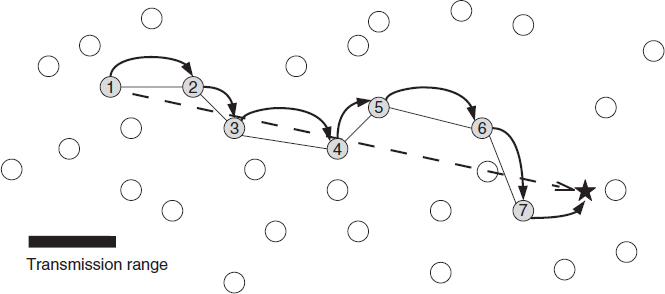10.3 MOBILE SENSOR MIGRATION
After a mobile sensor makes its decision for self-deployment or relocation, it will migrate from its current position to the target position. Mobile sensor migration can be accomplished in a direct way or in a shifted manner. In direct migration, the sensor simply moves all the way to the target location. Owing to the potentially long moving distance, this method can cause long migration delay and large energy consumption on the migrating sensor. In shifted migration, a multi-hop migration path is built from the sensor to the target location. As illustrated in Figure 10.1, every sensor along this path shifts its position by one-hop toward the target location. The last sensor in the path moves to the target location.

Figure 10.1 Shifted migration method.
Compared with direct migration, shifted migration may generate longer total moving distance and a larger number of moves, because migration path is usually not short and often composed of multiple nodes. However, instead of punishing only one node, this method distributes energy consumption among all the nodes along the path, prolonging network lifetime as a whole. In addition, it renders migration latency proportional to the longest hop (not longer than the communication radius rc) rather than the Euclidean distance between the target location and the sensor. In these cases, shifted migration is more ...
Get Wireless Sensor and Actuator Networks: Algorithms and Protocols for Scalable Coordination and Data Communication now with the O’Reilly learning platform.
O’Reilly members experience books, live events, courses curated by job role, and more from O’Reilly and nearly 200 top publishers.

